In the almost fifty years since Jonestown, some of the questions that pertain to the cyanide used to poison 907 Peoples Temple members still linger:
- Who ordered the cyanide?
- Where did it come from and why did they order it?
- How much of it was present in Jonestown on November 18th, 1978?
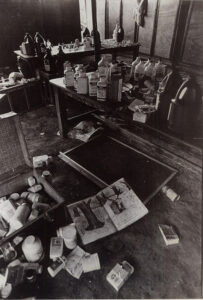
New research into the FBI files released through Freedom of Information Act requests allow us to answer some of these questions.
Before we begin, let us consider a few types of cyanide and their uses. Sodium cyanide and potassium cyanide, in a solid form called “salts,” can be used for medical laboratory testing, for metallurgical assaying (the chemical process of separating gold and silver from ore), as well as a pesticide. For these purposes, sodium cyanide and potassium cyanide may be used interchangeably. Additionally, cyanide is present in sodium ferricyanide, potassium ferrocyanide and potassium ferricyanide. Sodium and potassium ferrocyanide, with an “o,” can be used as an anti-caking agent in food-grade salt. Potassium ferricyanide, with an “i,” can be used as a laboratory reagent like sodium and potassium cyanide, that is, a substance used to create a chemical reaction in laboratories. Hydrogen cyanide, as a gas, was used under the name Zyklon-B by Nazi Germany in several key concentration camps during World War II.
Jonestown survivor Gerald Parks stated during his interview with the FBI following the deaths that he had seen “hundred pound bags of mono floro phosphate,” which he believed to be insecticide. According to Gerald Parks, Jonestown agronomist Russell Moton told him that it was poison. However, monofluorophosphate is a common ingredient in toothpaste, and there are no bags visible in known photos of the chemicals and drugs taken in the aftermath at Jonestown.
Another survivor, Richard Clark, reported that two 10 pound bags of cyanide arrived at the storage area where he worked about one week prior to Congressman Leo Ryan’s visit. Sodium cyanide and potassium cyanide are typically stored in glass or polyethylene containers, not bags. That said, potassium ferricyanide might be available in bags and was ordered by Jonestown staff for “soil analysis, other farm projects” although the Temple only appears to have initially ordered a single pound.
Who exactly ordered the cyanide and why? Where did they get it from? Reporter Jim Polk claimed in a 2008 CNN report that Jones had acquired a jewelers license for the purpose of buying cyanide to clean jewelry and had been purchasing pounds of the chemical “for at least two years” prior to November 18th, 1978. Polk said his source was someone with “first-hand involvement in the sale of cyanide” to Peoples Temple. This is unlikely, because the earliest Jonestown settlers probably would have been aware of the cyanide being in Jonestown, and Jones had little to no reason to be dealing in jewelry in Guyana in 1976. Jones might have purchased cyanide for assaying some of Guyana’s rich gold deposits, except that we don’t find any records of a Mining Department in Jonestown operations or staff assignments.
It was, in fact, Pauline Groot and Temple doctor Larry Schacht who ordered the cyanide. Pauline Groot was a 28-year-old who worked as a chemical engineer in Jonestown. Larry Schacht was a recovering drug addict from Houston who found recovery and a medical career with Peoples Temple. Groot ordered chemicals needed for the Temple laboratory which would use those chemicals to test things like soil, water, and bodily fluids. Specifically, Groot and Schacht ordered sodium cyanide for use in urinalysis and hemolysis.
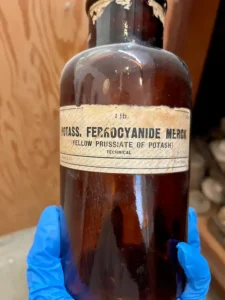
There is a two-page, typed list of chemicals that were “already on order from J.T. Baker” that includes sodium cyanide. At the end of the list is a note stating that the chemicals needed are based on recommendations from a “lab book.” There are multiple mentions of pricing and ordering from J.T. Baker Chemical Company. Conversely, there are two documents that mention VWR Scientific as a distributor for J.T. Baker and that their pricing was equal. Additionally, the Temple could order chemicals from Merck laboratories. J.T. Baker, VWR Scientific, and Merck all had California addresses available.
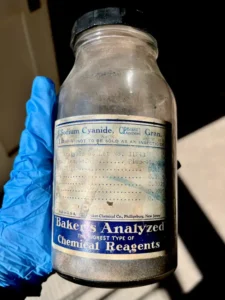
Additional notes found within this particular set of records tell us that the smallest amount of sodium cyanide sold by J.T. Baker is one pound which, in 1977 to 1978, cost $8.85. According to a technical document by Health Canada on cyanide, a lethal dose of cyanide for humans is around 1.52mg per kg of body weight. Considering many in Jonestown were malnourished and overworked, we’ll estimate the average weight of a Jonestown resident to be 150 lbs (68 kgs), and round the lethal cyanide dose to 2mg. 2mg x 68kg = 136mg. One pound of sodium cyanide equals 453,592.37mg, which when divided by 136, equals 3,335.24 lethal adult doses per pound.
An undated letter from Larry Schacht to Jim Jones, the context of which dates it around May 1978 after the defection of Debbie Layton, suggests testing two grams of cyanide on one of the Jonestown pigs but there is no record of any follow through. Roughly a month later, June 1st, 1978, Schacht writes to Jones that he feels “quite capable of organizing the suicide aspect,” and that they will need “cyanide tablets (potassium or sodium cyanide)” to produce botulism with vegetable canning jars. The context of the letter may imply that Schacht was attempting to create biological weapons.
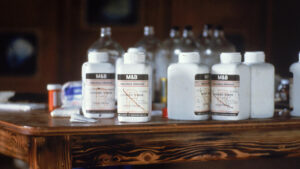
A key source in the story of cyanide in Jonestown is Matthew Naython’s photo of opened bottles of potassium cyanide. Going back to the second paragraph of this writing, you’ll remember that in solid form, salts, sodium cyanide and potassium cyanide can be used interchangeably.
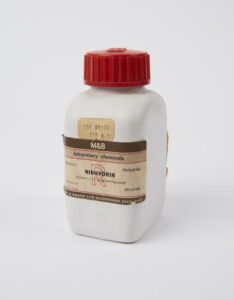 What’s most interesting is that the labels on the bottles are not J.T. Baker Chemical Company or Merck, but M&B. This likely stands for May & Baker, a British chemical production company. May & Baker also sold their products to the British Commonwealth of Nations, including British Guiana. It is likely that even though Guyana had reclaimed its sovereignty they continued to use existing processes including acquiring chemicals from companies with established business in the area. Naython’s photo along with another photo of the same table acquired through a Freedom of Information Act show us there were at least six bottles, four of which are clearly potassium cyanide, the others at least have the same M&B labels. Guyana’s Assistant Chief of Police, C.A. “Skip” Robert’s, testified during the Guyana Inquest to having seen “about 7 (1 liter) bottles containing potassium cyanide.”
What’s most interesting is that the labels on the bottles are not J.T. Baker Chemical Company or Merck, but M&B. This likely stands for May & Baker, a British chemical production company. May & Baker also sold their products to the British Commonwealth of Nations, including British Guiana. It is likely that even though Guyana had reclaimed its sovereignty they continued to use existing processes including acquiring chemicals from companies with established business in the area. Naython’s photo along with another photo of the same table acquired through a Freedom of Information Act show us there were at least six bottles, four of which are clearly potassium cyanide, the others at least have the same M&B labels. Guyana’s Assistant Chief of Police, C.A. “Skip” Robert’s, testified during the Guyana Inquest to having seen “about 7 (1 liter) bottles containing potassium cyanide.”
Jonestown survivor Juanita Bogue claimed that Dale Parks, son of Gerald Parks, had observed “cases” of cyanide arriving in Jonestown at least a month prior to the mass death event. In an interview with the FBI in December of 1978, Dale Parks states that he “had no knowledge” of cyanide in the community. The idea of “cases,” multiple, is unlikely as the above photos show limited amounts of potassium cyanide and the amount shown was more than enough to kill the entire community. One of these photos also shows large glass and polyethylene jugs which are common containers for laboratory chemicals but none of the labels are clear enough to allow us to identify the brand or chemical. Hydrogen cyanide, in liquid form, might have been stored in jugs like these but, due to its volatile nature with a boiling point only slightly above room temperature, it would have been too much of a risk to store in the hot, humid environment of the Guyanese jungle.
We may never know exactly how much potassium cyanide or sodium cyanide was present at any given moment in Jonestown, but we do know that Dr. Larry Schacht and chemical engineer Pauline Groot were capable of and actively ordering various chemicals for the purposes of laboratory testing. We know that Peoples Temple used J.T. Baker Chemical Company as a pricing and availability reference, though it appears that, in the end, the product was supplied by the British company May & Baker. Finally, while we may never know who was involved with planning the final White Night and at what level, we do know that Schacht was studying cyanide toxicity and biological weapons several months prior to his death and that of 906 others.
(Author’s note: I am a Park Ranger at a State Historic Park which includes mining and mineral assaying exhibits. Through my work transcribing Medical Records for the Jonestown Institute and knowledge gained from my career I was able to connect the primary sources found within RYMUR 89-4286-OO-3. My primary research focus is addiction within the Peoples Temple story.)
(Editor’s note: Brittni Criglow’s other article in this edition of the jonestown report is “You Don’t Tell God He’s Got a Drug Problem”: Addiction’s Role in Peoples Temple.)